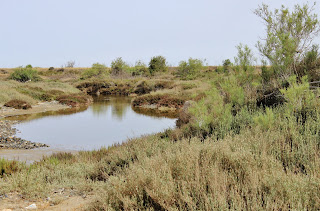Family Cardiidae
Σε λίμνες με υφάλμυρα νερά στο κατεχόμενο χωριό Συριανοχώρι
Synonyms
Cardium glaucum Poiret, 1789
Cerastoderma lamarcki (Reeve, 1845)
 Cerastoderma glaucum, commonly known as the lagoon cockle, is a species of saltwater clam, a marine bivalve mollusc in the family Cardiidae, the cockles.
Cerastoderma glaucum, commonly known as the lagoon cockle, is a species of saltwater clam, a marine bivalve mollusc in the family Cardiidae, the cockles.
 This species is found along the coasts of Europe and North Africa, including the Mediterranean and Black Seas and the Caspian Lake, and the low-salinity Baltic Sea. It is a euryhaline species living in salinities 4-100 ‰. In north-west Europe (including the British Isles), it typically does not live on open shores but rather in shallow burrows in saline lagoons, or sometimes on lower shores in estuaries. It cannot tolerate significant exposure to the air. The form found in lagoons is thinner-shelled than the estuarine populations.
This species is found along the coasts of Europe and North Africa, including the Mediterranean and Black Seas and the Caspian Lake, and the low-salinity Baltic Sea. It is a euryhaline species living in salinities 4-100 ‰. In north-west Europe (including the British Isles), it typically does not live on open shores but rather in shallow burrows in saline lagoons, or sometimes on lower shores in estuaries. It cannot tolerate significant exposure to the air. The form found in lagoons is thinner-shelled than the estuarine populations.
The lagoon cockle can grow to the length of 50 mm. In north-west Europe, it spawns in May-July, and the planktonic larval phase takes 11-30 days. The life span of the settled cockle is typically 2-5 years.
The species was described as Cardium glaucum in 1789 almost simultaneously both by Bruguière and by Poiret.
From Wikipedia, the free encyclopedia
Photos Sirgianochori 13/5/2016 by George Konstantinou
Synonyms
Cardium glaucum Poiret, 1789
Cerastoderma lamarcki (Reeve, 1845)
 Cerastoderma glaucum, commonly known as the lagoon cockle, is a species of saltwater clam, a marine bivalve mollusc in the family Cardiidae, the cockles.
Cerastoderma glaucum, commonly known as the lagoon cockle, is a species of saltwater clam, a marine bivalve mollusc in the family Cardiidae, the cockles. This species is found along the coasts of Europe and North Africa, including the Mediterranean and Black Seas and the Caspian Lake, and the low-salinity Baltic Sea. It is a euryhaline species living in salinities 4-100 ‰. In north-west Europe (including the British Isles), it typically does not live on open shores but rather in shallow burrows in saline lagoons, or sometimes on lower shores in estuaries. It cannot tolerate significant exposure to the air. The form found in lagoons is thinner-shelled than the estuarine populations.
This species is found along the coasts of Europe and North Africa, including the Mediterranean and Black Seas and the Caspian Lake, and the low-salinity Baltic Sea. It is a euryhaline species living in salinities 4-100 ‰. In north-west Europe (including the British Isles), it typically does not live on open shores but rather in shallow burrows in saline lagoons, or sometimes on lower shores in estuaries. It cannot tolerate significant exposure to the air. The form found in lagoons is thinner-shelled than the estuarine populations.The lagoon cockle can grow to the length of 50 mm. In north-west Europe, it spawns in May-July, and the planktonic larval phase takes 11-30 days. The life span of the settled cockle is typically 2-5 years.
The species was described as Cardium glaucum in 1789 almost simultaneously both by Bruguière and by Poiret.
From Wikipedia, the free encyclopedia
Photos Sirgianochori 13/5/2016 by George Konstantinou








No comments:
Post a Comment